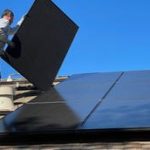By Max Oppen
HAINES FALLS — To bring renewable energy solutions closer to local communities, a clean energy company called Nexamp has proposed the development of a 2.25-megawatt community solar farm in Haines Falls. The project, which marks a significant step towards sustainable energy practices in the area, was presented by Nexamp’s representative, Eamon Riley, alongside Stephanie Alessandrini, a senior engineer with the Clifton Park-based Environmental Design Partnership, during a recent Town of Hunter Planning Board meeting held on April 2.
The proposed site for the community solar farm spans a 194-acre parcel owned by Sudha Patel, located off County Route 25. Patel has agreed to lease the land to Nexamp for the development of the solar project, which would be the first of its kind since the implementation of the Town of Hunter’s Solar Law.
The Town’s commitment to renewable energy is reflected in its Solar Law, which provides guidelines for residential and commercial solar projects. The law’s purpose is to “promote the effective and efficient use of solar energy systems; set provisions for the sensible placement, design, construction, and operation of such systems in such a way as to be consistent with the Town of Hunter Comprehensive Plan; to uphold the public health, safety and welfare; and to ensure that such systems will not have a significant adverse impact on the environment or the aesthetic qualities and character of the Town.”
Supervisor Mahoney emphasized the Town’s dedication to sustainability while protecting its natural resources, stating, “This Town wants to support renewable energy and we’ve made a commitment to do that and to be as sustainable as possible. However, people are here because of the mountains and forests, and we must protect those natural resources.”
The proposed project, estimated to cost between $8 and $10 million, faces some challenges, notably the need to clear 22.7 acres of woodland on the proposed site. Nexamp is seeking a variance from the Town of Hunter to proceed with this aspect of the project, with a request scheduled to be brought before the Town Board on April 23.
Addressing the community’s concerns about the environmental impact and accessibility of the project, Riley emphasized the local benefits, stating, “The power produced by the project stays local to the community in which it sits.” He further added, “Anybody who lives in the area where the community solar is located is eligible to subscribe to the community solar project and receive a 10-15% savings on the power portion of their utility bill.”
Nexamp’s business model reflects its commitment to decentralized energy systems and affordability. Zaid Ashai, Chairman and CEO of Nexamp, highlighted the company’s vision: “Solar power belongs everywhere.” He emphasized the importance of offering subscribers savings on electricity costs and making clean energy accessible.
In addition to its environmental benefits, the project holds economic promise for the region. Riley mentioned that Nexamp would engage local construction companies, paying prevailing wages for their services. The project would also be subsidized by state and federal tax incentives and private funding, focusing on utilizing American-made solar panels and inverters.
Town Supervisor Sean Mahoney supports utilizing the old Hunter Landfill site for this project instead, stating, “I think it’s an ideal location for a solar array.” Supervisor Mahoney took Riley on a tour of the Hunter Landfill earlier this month. Riley vocalized hesitations about building on the brownfield site due to state regulatory and size constraints but said, “We are genuinely interested in uncovering the viability of that brownfield site. If it is a true possibility, we will pursue it.”
Nexamp currently holds a rating of 2.14 stars out of 5 stars on the Better Business Bureau website, as per public commentary. This score is an aggregate of 73 customer reviews available at www.bbb.org.
Once construction commences, wherever it may be, the project is expected to go online in approximately 6-8 months, providing clean energy to hundreds of homes in the area. This proposed community solar farm would be the first of its kind in the area and, therefore, would set a precedent for future projects.
Remember to Subscribe!| Subscription Options |
![]()
This post was originally published on 3rd party site mentioned in the title of this site






